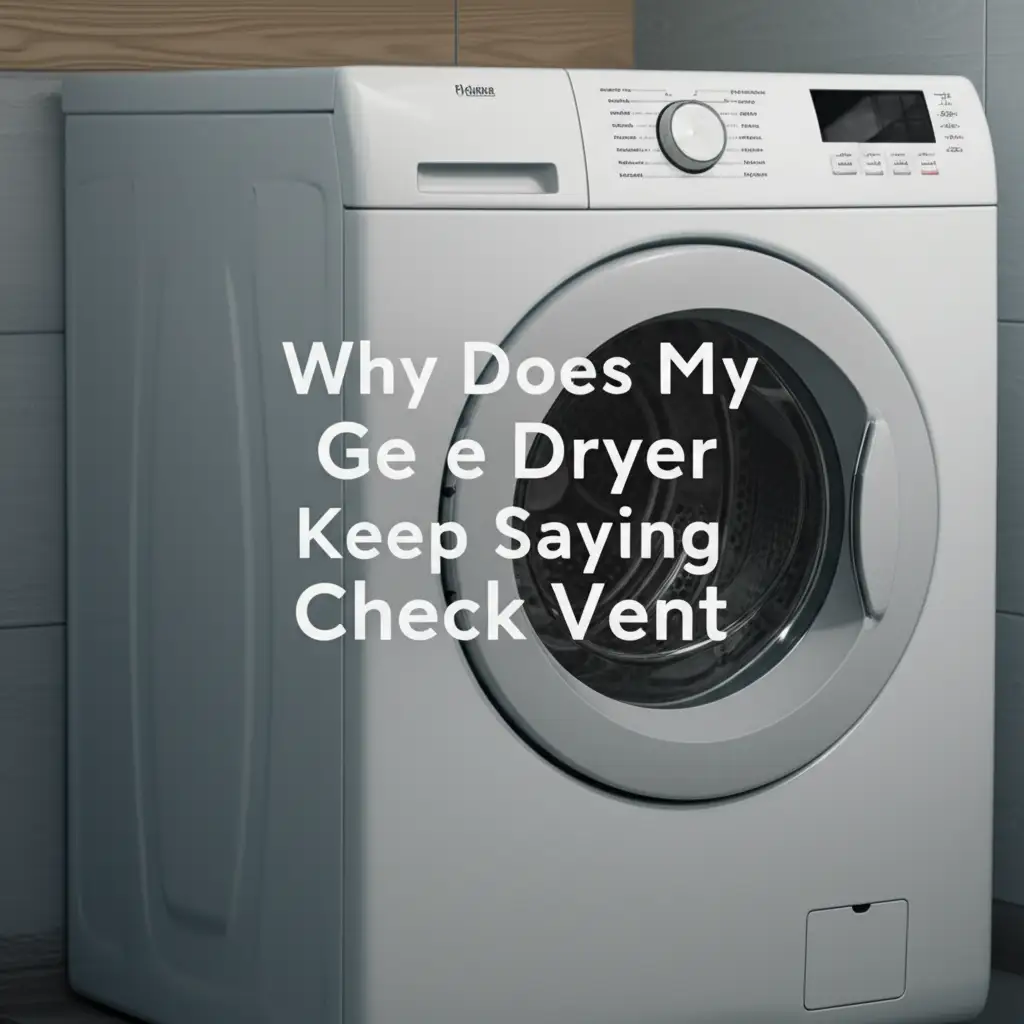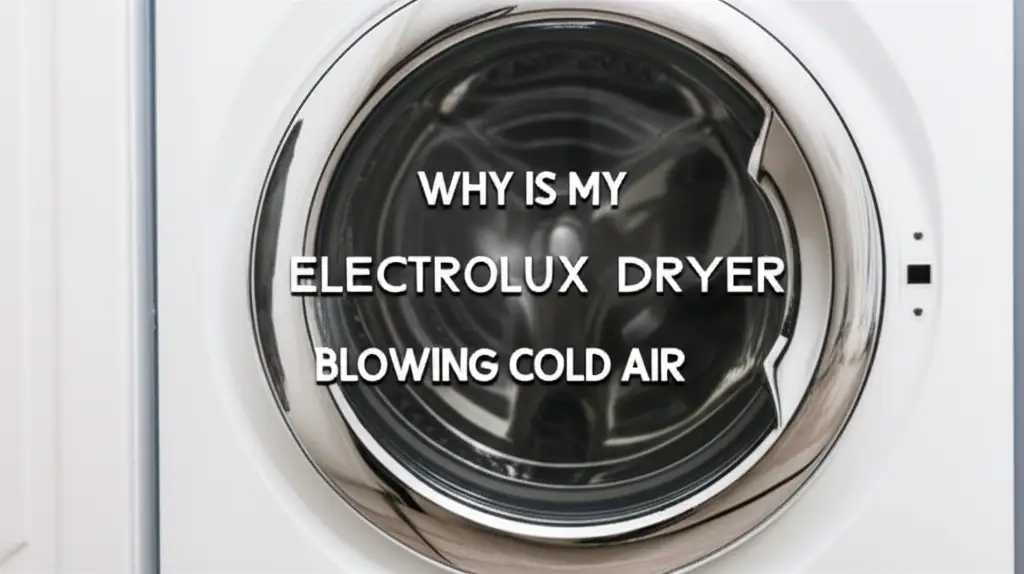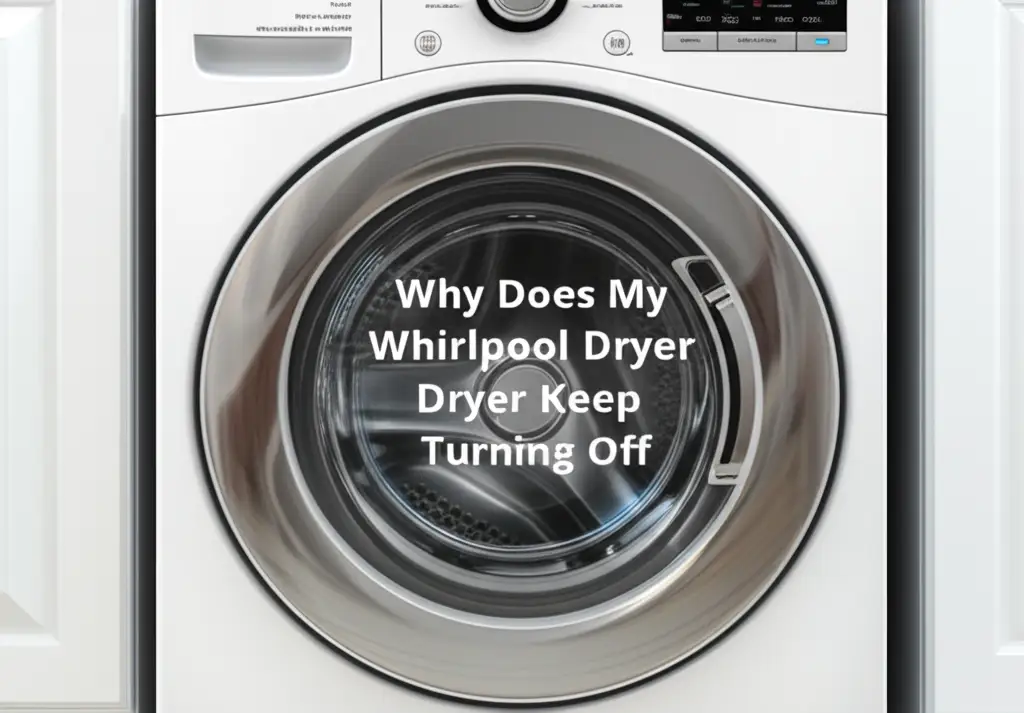· Todd Martin · Appliance Repair · 19 min read
Why Does My Ge Dryer Keep Saying Check Vent

Resolve Your GE Dryer’s Check Vent Error Promptly
There are few things as frustrating as a laundry day interrupted. Your clothes are wet, but your GE dryer keeps saying “Check Vent.” This message is a common alert. It signals a potential issue with your dryer’s airflow system. Ignoring this warning leads to poor drying performance. It also poses significant safety risks, including fire hazards. Understanding the root causes of this error allows you to take action. You can restore your dryer’s efficiency and ensure your home’s safety.
This article guides you through a clear process. We explore common reasons why your GE dryer displays the “Check Vent” message. We cover everything from simple lint trap issues to complex vent blockages. We will provide detailed, actionable steps for troubleshooting and resolving the problem. You will learn how to identify the exact cause. We offer practical solutions for various scenarios. This includes cleaning different parts of the vent system. You will discover preventative measures to avoid future alerts. Proper dryer maintenance is key. It helps you keep your appliance running smoothly. It ensures your clothes dry quickly and safely. Let us make laundry day hassle-free again.
Takeaway
- Clean the Lint Filter: Clean your lint filter before every load. This is the first and simplest step.
- Inspect the Dryer Vent Hose: Check the flexible hose behind your dryer for kinks, crushes, or disconnections.
- Clear the Main Vent Duct: Regularly clean the entire dryer vent duct from the dryer to the exterior vent cap.
- Check the External Vent Hood: Ensure the outdoor vent cap is free of lint, debris, and animal nests.
- Consider Sensor Issues: If cleaning does not help, a faulty sensor may be causing the error.
- Prioritize Safety: A “Check Vent” error indicates restricted airflow, a fire hazard. Address it immediately.
Why does my GE dryer keep saying Check Vent?
Your GE dryer keeps saying “Check Vent” because its internal sensors detect restricted airflow. This restriction usually comes from a clogged lint filter, a kinked or crushed exhaust hose, a blocked main vent duct, or an obstructed external vent hood. Addressing these blockages improves efficiency and prevents fire hazards.
Understanding the ‘Check Vent’ Message on Your GE Dryer
The “Check Vent” message on your GE dryer is more than just an inconvenience. It is a critical warning. This alert means your dryer’s sensors detect an issue with airflow. The dryer relies on proper air circulation to dry clothes efficiently. It also needs it to operate safely. When airflow is restricted, hot air gets trapped inside the drum. This leads to higher internal temperatures. This scenario presents a risk. It can cause clothes to overheat or, in severe cases, ignite lint.
GE dryers are equipped with sophisticated sensors. These sensors monitor various conditions. They include temperature and moisture levels within the dryer. They also monitor the exhaust airflow. If the exhaust temperature is too high, or if airflow is too low, the dryer triggers this warning. It might even shut down as a safety measure. The primary goal of this message is to protect your appliance and your home. It prompts you to investigate and clear any obstructions. Addressing this error promptly is important. It prevents damage to your dryer. It also helps you avoid potential fire hazards.
Many common issues can cause this airflow restriction. Lint buildup is the most frequent culprit. Over time, lint escapes the filter. It then accumulates in the vent system. This buildup creates a barrier. It blocks the hot, moist air from escaping. Other factors include crushed vent hoses or obstructed outdoor vent caps. Understanding this message’s importance is the first step. It helps you effectively troubleshoot the problem. We want to ensure your dryer operates safely and efficiently for years. Restricted airflow also makes your dryer work harder. This increases energy consumption. It also prolongs drying times. If your dryer takes too long to dry clothes, a restricted vent is often the reason. You can learn more about this common issue by visiting our guide on Why Does My GE Dryer Take So Long to Dry.
Moreover, continued operation with a restricted vent leads to component failure. Overheating damages heating elements, thermal fuses, and motors. This results in costly repairs. Sometimes it requires dryer replacement. Addressing the “Check Vent” alert safeguards your investment. It ensures your laundry routine remains smooth. Ignoring the error can lead to a dryer that runs but produces no heat. This is another common symptom of vent blockage, which you can investigate further in our article about Why Does My GE Dryer Run But No Heat. Always prioritize immediate action when this warning appears. Your safety and the longevity of your appliance depend on it.
Clogged Dryer Vent: The Primary Culprit
A clogged dryer vent system is the most frequent reason your GE dryer says “Check Vent.” Lint is highly flammable. It accumulates in the vent ducts over time. This creates a dangerous fire hazard. Beyond safety, a clogged vent severely reduces your dryer’s efficiency. Hot, moist air cannot escape properly. This leads to longer drying cycles. It also causes clothes to remain damp. Your energy bills might increase too.
Identifying a Clogged Vent
Several signs indicate a clogged dryer vent. Your clothes may take much longer to dry than usual. They might feel unusually hot or damp after a cycle. The dryer itself could feel very hot to the touch. You might also notice a burning smell, often described as a “burnt lint” odor. The laundry room may become excessively humid or hot during dryer operation. These are all indicators of restricted airflow. When you see the “Check Vent” error, it confirms these symptoms. The dryer’s sensors have detected the problem.
Steps to Inspect and Clean Your Vent
Cleaning your dryer vent is a crucial maintenance task. It typically involves a few key steps. First, disconnect your dryer from its power source. Then, detach the vent hose from the back of the dryer. Use a vacuum cleaner with a long attachment to remove visible lint from the dryer’s exhaust port. Next, inspect the vent hose itself. Clear any visible blockages. For the main vent duct running through your wall or floor, use a dryer vent cleaning brush kit. These kits usually include a long, flexible brush that connects to a drill. Insert the brush into the duct. Work it back and forth to dislodge lint. You can often clean from both ends. This means starting from the dryer side and also from the exterior vent cap.
For a comprehensive guide on cleaning, you can refer to our detailed article on How to Clean Dryer Vent. This resource provides step-by-step instructions. It ensures you perform the cleaning safely and effectively. Remember, regular vent cleaning prevents the “Check Vent” error. It also safeguards your home. Neglecting this maintenance can lead to serious consequences. Make it a routine part of your home care. This simple task prolongs your dryer’s life. It keeps your family safe.
Furthermore, consider the pathway your dryer vent takes. Does it run a long distance? Does it have many turns? Longer and more convoluted vent paths are more prone to blockages. Each bend creates a spot where lint can settle and accumulate. Ensure your vent hose meets proper specifications. The recommended material is rigid metal ducting. This type of ducting offers minimal friction. It resists crushing. Flexible foil or plastic hoses are less ideal. They trap lint more easily. They also tear or crush, impeding airflow. Verify that your vent exits properly to the outside. It should not vent into an attic, crawl space, or garage. This creates moisture issues and fire hazards. Understanding proper ventilation is key. Our article Does An Electric Dryer Vent Have to Go Outside provides essential information on this topic. Ensure your dryer vents to the outdoors for safety and efficiency.
Beyond the Main Vent: Lint Trap and Internal Ducts
While the main dryer vent duct is a common source of the “Check Vent” error, other areas also contribute. The lint trap and the internal ducts within your GE dryer are critical. They require regular attention. Neglecting these areas causes significant airflow restrictions. Even if your main vent duct is clear, blockages here will trigger the error.
The Lint Trap: Your First Line of Defense
The lint trap is designed to catch lint from your clothes. It prevents it from entering the dryer’s exhaust system. You should clean this filter before every single load. This simple habit makes a big difference. A clogged lint filter drastically reduces airflow. This makes your dryer work harder. It lengthens drying times. It also causes the “Check Vent” message to appear. To clean it, simply pull it out. Remove any accumulated lint. You can also occasionally wash the lint filter. Use warm, soapy water. This removes fabric softener residue. This residue builds up over time. It can block the fine mesh of the filter. Let the filter dry completely before putting it back.
Clearing Internal Dryer Ducts and Housing
Even with a clean lint filter, some lint bypasses it. This lint settles in the internal ducts and housing of your dryer. Over time, this buildup can become substantial. These internal areas include the dryer’s blower wheel and the housing around the heating element. Accessing these parts often requires disassembling parts of the dryer. This can be more complex than cleaning the main vent.
Here is a general approach for internal cleaning:
- Disconnect Power: Always unplug your dryer from the electrical outlet.
- Access Panels: Depending on your GE dryer model, you might need to remove the rear panel, top panel, or front panel. Consult your owner’s manual for specific instructions.
- Vacuum Lint: Use a vacuum cleaner with a narrow attachment to carefully remove lint. Pay attention to the areas around the heating element and the blower wheel. Be gentle around electrical components.
- Inspect Blower Wheel: Ensure the blower wheel is free of obstructions. Lint or small items can get caught in the fan blades. This hinders airflow.
- Reassemble: Put all panels back securely. Ensure no wires are pinched. Reconnect power.
If you are unsure about disassembling your dryer, consider professional help. A technician can safely clean these internal components. Regular professional internal cleaning is part of comprehensive dryer maintenance. For general care and cleaning tips specifically for your GE dryer, you can refer to our guide on How to Clean GE Dryer. This resource covers various aspects of dryer maintenance. It helps keep your appliance in top condition. Neglecting internal lint buildup can lead to recurring “Check Vent” errors. It compromises both efficiency and safety. Consistent attention to all parts of the dryer’s airflow system is key.
Examining the Dryer’s Exhaust Hose and Connections
The exhaust hose is the flexible duct connecting your GE dryer to the main vent system. This component is often overlooked. It plays a critical role in airflow. Issues with the hose itself or its connections are common causes for the “Check Vent” error. It’s important to inspect this part thoroughly.
Common Problems with the Exhaust Hose
- Kinks and Crushes: The most frequent problem is a kinked or crushed hose. Dryers are often pushed too close to the wall. This can flatten the flexible hose. A restricted hose severely limits airflow. This immediately triggers the “Check Vent” error.
- Disconnections: The hose can become disconnected from either the dryer’s exhaust port or the wall vent. This creates a gap. Hot, moist air then escapes into your laundry room. This increases humidity and causes potential mold growth. It also means no air is moving through the actual vent system. This fools the dryer’s sensors into thinking there’s no airflow.
- Excessive Length or Bends: An exhaust hose that is too long or has too many sharp bends also restricts airflow. Each bend reduces air velocity. It creates more opportunities for lint to accumulate. The ideal setup is a short, straight hose.
- Improper Material: While flexible foil or plastic hoses are common, rigid metal ducting is superior. Flexible hoses collapse more easily. They also collect lint more readily due to their ribbed interior. If you have a plastic or foil hose, consider upgrading to a semi-rigid or rigid metal duct.
Steps to Inspect and Fix the Exhaust Hose
- Disconnect Power: Always unplug your GE dryer before beginning any inspection or repair. Safety is paramount.
- Pull Dryer Out: Gently pull your dryer away from the wall. This provides ample space to access the rear.
- Inspect the Hose: Carefully examine the entire length of the flexible exhaust hose. Look for any visible kinks, crushes, or tears. Gently straighten out any kinks you find.
- Check Connections: Verify that both ends of the hose are securely attached. The hose should be clamped tightly to the dryer’s exhaust port and the wall vent opening. If a clamp is loose, tighten it. If the hose has come off, reattach it and secure it with a new clamp if needed.
- Clean the Hose: If the hose itself is full of lint, detach it completely. Shake it out outdoors. Use a long brush or vacuum attachment to clear any remaining lint. If it’s heavily clogged or damaged, replacing it is often the best option.
- Optimize Layout: When pushing the dryer back, leave enough space behind it. Prevent the hose from kinking. Aim for the shortest, straightest path possible for the hose. Avoid sharp 90-degree bends. Use wide turns if bends are necessary.
Ensuring your dryer’s exhaust hose is in good condition and properly installed is a quick fix. It often resolves the “Check Vent” error. This simple check maintains efficient operation. It reduces the risk of fire. It is an essential part of your regular dryer maintenance routine. Sometimes, general vent cleaning involves tools that can reach these hose sections. Our guide on How to Clean Vent offers broader strategies for effective airflow maintenance, which can be applied to the exhaust hose as well.
External Vent Hood Obstructions and Animal Nests
After checking the internal components and the dryer hose, your attention must turn to the exterior. The external vent hood is the final point of exit for air. It often becomes a collection point for lint, debris, and even animal nests. An obstructed external vent hood is a very common cause of the “Check Vent” error on your GE dryer.
Why External Obstructions Happen
The external vent hood typically has a flap or louvers. These open to allow air out and close to prevent pests and weather elements from entering. Over time, lint expelled from the dryer clings to these flaps and the surrounding mesh. This buildup gradually restricts the opening. Leaves, dirt, and other outdoor debris can also accumulate. Furthermore, small animals like birds or rodents find these vent openings appealing. They often build nests inside the vent hood or directly in the ductwork. These nests create severe blockages. They pose a significant fire risk due to the highly flammable nature of lint mixed with nesting materials.
Inspecting and Cleaning the External Vent Hood
Accessing and cleaning the external vent hood requires careful steps.
- Locate the Vent: Find where your dryer vents to the outside of your house. It is usually on an exterior wall near your laundry area.
- Safety First: Ensure your dryer is off and unplugged. Wear gloves, especially if you suspect animal activity. You might need a ladder if the vent is high up. Have someone spot you if using a ladder.
- Clear Visible Obstructions: Remove any visible lint buildup around the vent opening and on the flaps or louvers. If there’s a screen, clear it thoroughly.
- Check for Nests: Look inside the vent opening for signs of animal nests. If you find one, carefully remove it. Use a long brush or a vacuum cleaner with an extension. Be cautious, as animals might still be present or aggressive. If an animal is actively using the vent, you may need professional pest removal first.
- Clean Inside the Opening: Use a dryer vent brush or a strong vacuum to reach as far into the duct as possible from the outside. This helps dislodge any lint that has accumulated just inside the opening.
- Test the Flap: Ensure the vent flap or louvers open and close freely. If they are stuck due to lint or damage, clean or repair them.
Regular cleaning of the external vent hood is essential. It prevents future blockages. It helps maintain optimal airflow for your GE dryer. Consider installing a pest-proof vent cover. Make sure it does not restrict airflow excessively. Some covers have very fine mesh that traps lint. Choose one designed for dryer vents. It should have larger openings to allow lint passage while deterring animals.
Cleaning the external vent from the roof is also an option for some vent setups. If your vent exits through the roof, this will be your primary access point for exterior cleaning. We provide detailed steps for this specific task in our article, How to Clean Dryer Vent on Roof. This ensures that even the highest and most challenging parts of your vent system remain clear. Combining these external cleaning efforts with internal vent maintenance ensures your dryer operates without the “Check Vent” error.
Sensor Malfunctions and Advanced Troubleshooting
After thoroughly inspecting and cleaning all parts of the vent system, your GE dryer might still display the “Check Vent” error. In such cases, the problem likely stems from a malfunctioning sensor. GE dryers use various sensors to monitor conditions. These sensors include temperature sensors, moisture sensors, and sometimes dedicated vent sensors. A faulty sensor sends incorrect data to the dryer’s control board. This triggers the “Check Vent” warning, even if airflow is actually clear.
Common Sensors Involved
- Vent Thermistor/Sensor: This sensor monitors the temperature of the air exiting the dryer. If it detects abnormally high temperatures, it signals restricted airflow. A faulty thermistor might inaccurately report high temperatures. This causes the error.
- Moisture Sensor Bars: Located inside the dryer drum, these bars detect the moisture level of your clothes. While not directly related to the vent, extreme moisture readings due to a malfunctioning sensor could indirectly affect drying cycles. This may lead to the control board misinterpreting an issue.
- Thermal Fuse/Thermostat: These are safety devices. They trip or blow if temperatures within the dryer exceed safe limits. While a blown thermal fuse usually results in no heat or no operation, a failing one might send intermittent signals. This could confuse the dryer’s control system.
Diagnosing a Faulty Sensor
Diagnosing a faulty sensor often requires a multimeter. This tool measures electrical resistance (ohms). Each sensor has a specific resistance range. This range changes with temperature. You can usually find the correct resistance values in your GE dryer’s service manual.
Here’s a general approach:
- Disconnect Power: Always unplug the dryer before attempting any electrical checks.
- Access the Sensor: Locate the sensor in question. The vent thermistor is usually near the exhaust ducting inside the dryer. Accessing it often requires removing a rear or front panel.
- Test with Multimeter: Disconnect the sensor’s wires. Set your multimeter to measure ohms. Place the probes on the sensor’s terminals. Compare the reading to the specifications in your dryer’s manual. Test at room temperature first. Then, you might need to warm the sensor (e.g., with a hairdryer) and observe changes in resistance.
- Visual Inspection: Look for any visible damage to the sensor or its wiring. Frayed wires or corroded terminals can disrupt signals.
If a sensor’s reading is outside the specified range, it needs replacement. Replacement parts are specific to your GE dryer model. You can find model numbers inside the dryer door or on the back panel.
Advanced Troubleshooting and When to Call a Professional
If you are uncomfortable with electrical testing or dryer disassembly, do not attempt these repairs. Electrical components can be dangerous. Incorrect installation causes further damage. A professional appliance technician has the tools and expertise. They can accurately diagnose sensor issues or control board problems.
Sometimes, simply resetting the dryer can clear a false error. Unplug the dryer for a few minutes. Then, plug it back in. This often resets the control board. It clears temporary glitches. If the error persists after all cleaning and basic troubleshooting, a service call is warranted. A technician can also check the control board itself. A faulty control board might misinterpret sensor signals. It can improperly trigger the “Check Vent” error. This is a rare cause. However, it is possible if all other solutions fail.
Addressing sensor malfunctions requires precision. It ensures your GE dryer operates correctly and safely. Investing in professional diagnostics prevents prolonged issues. It also extends your dryer’s lifespan.
Preventative Maintenance to Avoid Future ‘Check Vent’ Alerts
Preventative maintenance is the best defense against your GE dryer displaying the “Check Vent” error again. A proactive approach saves you time, money, and stress. It also significantly reduces fire risks associated with lint accumulation. By establishing a routine, you ensure optimal performance and extend your dryer’s lifespan.
Daily Maintenance: The Lint Filter
- Clean Before Every Load: This is the golden rule of dryer maintenance. Make it a habit to remove lint from the lint filter before starting each new load. A clean filter ensures maximum airflow. It prevents lint from bypassing the filter and accumulating in the vent system. This simple action is your most powerful tool. It directly impacts your dryer’s efficiency and safety.
- Wash the Lint Filter Periodically: Every few months, or if you notice clothes taking longer to dry even with a clean filter, wash the lint filter. Use warm, soapy water and a soft brush. This removes waxy buildup from fabric softeners and dryer sheets. This buildup can create an invisible film. It restricts airflow through the mesh. Rinse thoroughly and allow the filter to air dry completely before reinserting it.
Monthly/Quarterly Maintenance: Exhaust Hose and Dryer Interior
- Inspect and Clean Exhaust Hose: Pull your GE dryer away from the wall. Inspect the flexible exhaust hose for kinks, crushes, or tears. Straighten any kinks. Use a vacuum cleaner to clear any lint visible inside the hose. Ensure connections to the dryer and wall are secure. Consider upgrading older foil or plastic hoses to rigid or semi-rigid metal ones. These are less prone to kinking and lint buildup.
- Vacuum Dryer Interior: Disconnect power. Carefully remove the bottom kick plate or rear panel. Use a vacuum cleaner with a narrow attachment. Remove lint from around the motor, heating element, and internal ductwork. This prevents buildup in areas inaccessible during routine lint filter cleaning.
Annual Maintenance: The Main Vent Duct and Exterior Vent Hood
- Professional Vent Cleaning (Recommended): Schedule a professional dryer vent cleaning at least once a year. This is especially important for longer vent runs or those with multiple bends. Professionals have specialized tools. They can thoroughly clean the entire duct from end to end. This includes areas you cannot reach.
- DIY Vent Cleaning: If you prefer a DIY approach, purchase a dryer vent cleaning kit. These kits usually come with a brush that attaches to a drill. Clean the vent from both ends: from behind the dryer and from the exterior vent hood. This method effectively removes most lint buildup. Our guide on How to Clean Dryer Vent provides detailed instructions.
- Check Exterior Vent Hood: Inspect the outdoor vent cap. Clear any lint, leaves, or debris from the flaps or screen. Ensure the flaps open freely when the dryer is





